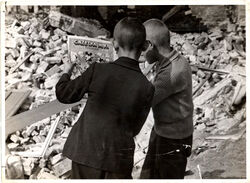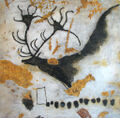Comics (nonfiction): Difference between revisions
No edit summary |
No edit summary |
||
| (11 intermediate revisions by the same user not shown) | |||
| Line 1: | Line 1: | ||
[[File:Two_young_Polish_boys_read_a_Polish_edition_of_Mickey_Mouse_(Warsaw_1939).jpg|250px|thumb|Two young Polish boys read a Polish edition of a Mickey Mouse Sunday colored supplement while standing among the ruins of a building in Warsaw. September 1939.]] | [[File:Two_young_Polish_boys_read_a_Polish_edition_of_Mickey_Mouse_(Warsaw_1939).jpg|250px|thumb|Two young Polish boys read a Polish edition of a Mickey Mouse Sunday colored supplement while standing among the ruins of a building in Warsaw. September 1939.]] | ||
Comics frequently takes the form of juxtaposed sequences of panels of images. Often textual devices such as [[speech balloons]], captions, [[cartouches]], and onomatopoeia indicate dialogue, narration, sound effects, or other information. Size and arrangement of panels contribute to narrative pacing. | |||
Since the late 20th century, bound volumes such as [[Graphic novel (nonfiction)|graphic novels]], comics albums, and ''tankōbon'' have become increasingly common, and online webcomics have proliferated in the 21st century. | |||
Scholars have posited a pre-history as far back as the [[:File:Lascaux Megaloceros.jpg|Lascaux cave paintings]]. | |||
== In the News == | |||
<gallery> | |||
File:Lascaux Megaloceros.jpg|Lascaux cave paintings [[Art (nonfiction)|tell it like it is]]. | |||
File:Diagramaceous soil bingo algorithm harvest.jpg|link=Diagramaceous soil|[[Speech balloon (nonfiction)|Algorithmic speech balloons]] harvested in record number, thanks to freshly enumerated [[Diagramaceous soil]]y. | |||
File:Jesse_Orion_40pitd020.png|''40 Peanuts in the Desert'' by Jesse Orion points the way. | |||
File:Manga_Hokusai.jpg|Hello World, says Manga Hokusai. | |||
File:Approved_by_the_Comics_Code_Authority.gif|link=Comics Code Authority (nonfiction)|[[Comics Code Authority (nonfiction)|Comics Code Authority symbol]] unemployed, will assert censorship authority for food. | |||
</gallery> | |||
== Fiction cross-reference == | |||
== | |||
[[ | * [[Gnomon algorithm]] | ||
== Nonfiction cross-reference == | == Nonfiction cross-reference == | ||
* [[Cartouche (nonfiction)]] | * [[Cartouche (nonfiction)]] | ||
* [[Graphic novel (nonfiction)]] | |||
* [[Speech balloon (nonfiction)]] | * [[Speech balloon (nonfiction)]] | ||
External links, general: | |||
* [https://en.wikipedia.org/wiki/Comics Comics] @ Wikipedia | |||
* [https://boingboing.net/2018/10/09/transmet-and-beyond.html Warren Ellis on the unique narrative power of comics] | |||
External links, specific: | |||
* [http://www.viruscomix.com/page567.html Anomalies] @ Virus Comics | |||
[[Category:Nonfiction (nonfiction)]] | [[Category:Nonfiction (nonfiction)]] | ||
[[Category:Comics (nonfiction)]] | [[Category:Comics (nonfiction)]] | ||
Latest revision as of 10:13, 9 October 2018
Comics frequently takes the form of juxtaposed sequences of panels of images. Often textual devices such as speech balloons, captions, cartouches, and onomatopoeia indicate dialogue, narration, sound effects, or other information. Size and arrangement of panels contribute to narrative pacing.
Since the late 20th century, bound volumes such as graphic novels, comics albums, and tankōbon have become increasingly common, and online webcomics have proliferated in the 21st century.
Scholars have posited a pre-history as far back as the Lascaux cave paintings.
In the News
Lascaux cave paintings tell it like it is.
Algorithmic speech balloons harvested in record number, thanks to freshly enumerated Diagramaceous soily.
Comics Code Authority symbol unemployed, will assert censorship authority for food.
Fiction cross-reference
Nonfiction cross-reference
External links, general:
External links, specific:
- Anomalies @ Virus Comics





